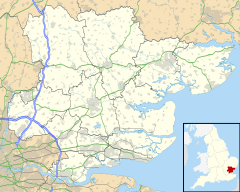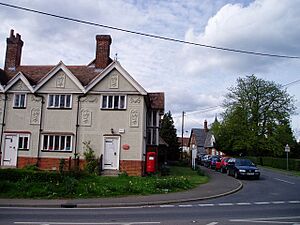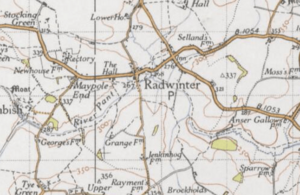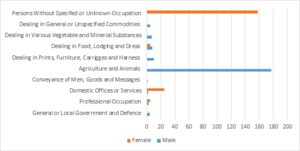Radwinter facts for kids
Quick facts for kids Radwinter |
|
|---|---|
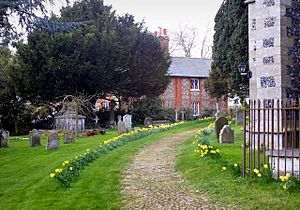 St Mary's Church |
|
| Population | 612 (2011) |
| Civil parish |
|
| District |
|
| Shire county | |
| Region | |
| Country | England |
| Sovereign state | United Kingdom |
| Post town | Saffron Walden |
| Postcode district | CB10 |
| Police | Essex |
| Fire | Essex |
| Ambulance | East of England |
| EU Parliament | East of England |
Radwinter is a small village in the Uttlesford area of Essex, England. It is located on the B1053 road. In 2011, about 612 people lived here. The village has a 14th-century church called St Mary the Virgin and a primary school.
Radwinter also includes four smaller areas, or hamlets. These are found between the towns of Saffron Walden in Essex and Haverhill in Suffolk. Long ago, the area was split into "Great Radwinter" and "Little Radwinter," but this division is no longer used.
Contents
Life in Radwinter
How Many People Live Here?
The number of people living in Radwinter has changed over time. In 2011, there were 612 residents. Most of these people, 460 of them, were between 18 and 89 years old. This means a large part of the population was of working age.
The population in 1800 was similar to 2011, around 600 people. However, the numbers have gone up and down. For example, the population grew from 819 in 1831 to 916 in 1951. This increase might be because the size of the parish grew from 3,100 acres in 1830 to 3,800 acres in 1850.
Jobs and Work
The types of jobs people do in Radwinter have changed a lot since the 1800s. In 1881, many women worked as domestic servants or in jobs related to food and clothing. This was common for that time. About 179 men worked in farming or with animals, showing that Radwinter was once a farming community.
By 2011, the job scene was much different. Many men worked in management or other professional roles. Women had a wider variety of jobs too. Many were in professional jobs, administrative roles, or caring services. This shows how the village has changed from a farming area to one with many different types of work.
Homes in the Village
In 2011, there were 229 homes in Radwinter. Many homes were lived in by families with children. Some people, especially those over 65, lived alone.
The value of homes in Radwinter has changed over time. In March 2017, the average house was worth about £632,311. Over the past ten years, the average house value has increased by about 33.6%. Smaller homes, like terraced and semi-detached houses, were valued lower than the average.
Radwinter's Community
Radwinter is a small village with a close-knit community. There are about 250 houses. Many of the older homes and cottages were built during the Tudor times, using oak wood from nearby forests. Other houses are even older but have been updated over the years. Newer houses from the 20th and 21st centuries can also be seen.
The heart of the community includes the parish church and the post office. There is also a village hall, a local primary school, and a sports ground. The village even has a pub and restaurant called The Plough Inn. Several important buildings in Radwinter are protected by law because of their history and special architecture. These include The Old Dairy, The Old Bakehouse, The Old Brewery, and Church Hill Cottages.
The Village Church
The Saint Mary the Virgin Church was first built in the 12th century. It is made from flint and white limestone, with a roof of tile and lead. This church has stood for about 700 years. The oldest parts of the church are the arches closest to the east. These arches used to have medieval paintings, but they were painted over in the 1860s.
In the 1850s, a porch, a new door, and a west tower with a spire were added to the church. Later, between 1868 and 1882, the church was renovated and made larger. A local reverend, John Frederick Walkinson Bullock, led this work and paid for most of it himself. During this time, parts of the church like the chancel and aisles were rebuilt using old materials. New organ rooms were also added, creating the church we see today.


